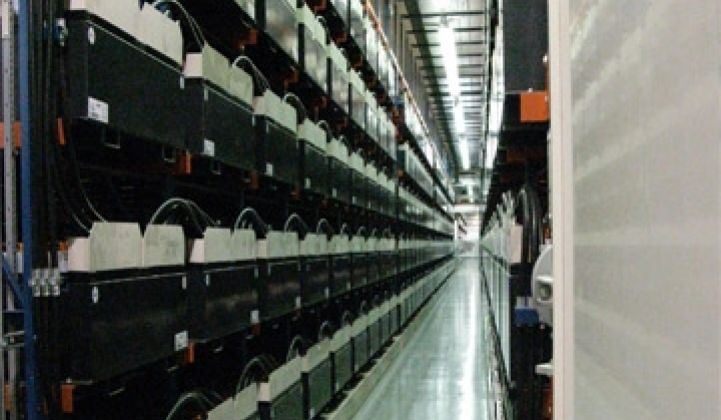Energy storage companies generally get their revenue by selling products.
But they might do better if they position themselves as mini-utilities.
To overcome some of the economic realities of the energy market and to better highlight some of the advantages of storage systems, makers of large-scale batteries, flywheels and other types of equipment may start to position themselves as power providers or service providers instead of manufacturers.
Take Beacon Power, for example. The Tyngsboro, Mass.-based company originally planned to sell its flywheels as a pieces of equipment to utilities to help fine-tune power output from power plants.
Instead, it has -- for now -- shifted to a service approach. It built a three-megawatt flywheel farm in New England and recently broke ground on another 20 megawatt farm in upstate New York. Beacon owns the farm and sells its capabilities as a service. Grid balancing and other so-called interconnect services could rise to $1 billion in a few years as more renewable parks get built, said CEO William Capp.
"Utilities don't want to make a big bet yet," he said. "We are acting as a utility in the state of New York."
By building its own flywheel park, Beacon can garner revenue in the near term, compile performance data, keep its factory humming and effectively serve as its own primary customer until utilities themselves want to purchase flywheels en masse.
Additionally, it gives Beacon a platform to experiment with ways to drive down costs. Now, a 20-megawatt flywheel park might cost $50 million. Beacon wants to drop that to $25 million or $30 million. Beacon could build larger parks, but it may hold steady at around the 20-megawatt level: it is easier to get approval for facilities providing this much power or less. (Storage companies rate their products by capacity -- in terms of kilowatts and megawatts -- and secondarily in the number of megawatt-hours a system can generate.)
Start-up Megawatt Storage Farms, co-founded by industry vet Ed Cazalet, wants one day to provide similar sorts of storage services in California. Meanwhile, Xtreme Storage wants to commercialize a dry-cell battery initially developed in the early 90s by Corning, British Aerospace and Ford Aerospace by making the storage system part and parcel of alternative energy power parks. In Hawaii, Xtreme's equipment will be deployed for voltage regulation at a wind farm. Department of Energy loans will provide the cash for both the turbines and the dry battery pack.
Xtreme also wants to integrate its batteries into the solar parks erected and operated by Clairvoyant Energy. Clairvoyant developed a 12-megawatt rooftop solar project in Zaragoza, Spain with General Electric and Veolia Environnement. Last year, Xtreme and Clairvoyant formed a joint venture to resuscitate a Ford manufacturing facility in Michigan.
"The new approach would be integrating our approach with large-scale solar," CEO Carlos Coe told us last November.
Does that make Xtreme a supplier of components to energy developers, or a partner in an energy development selling power? It's a distinction that is in the eye of the beholder (and the amortization allocation set by the accountant), but the line between product and service is clearly being blurred.
Thinking of storage as a service that competes or can substitute for conventional power tends also to enhance the economic potential because of the high costs associated with erecting new power plants. A 1.2-megawatt sodium sulfur storage facility in West Virginia commissioned in 2006 trimmed peak power in the region by 10% to 15% and postponed the need to erect another plant, according to Imre Gyuk, the project manager for energy storage systems research at the Department of Energy.
"The upgrade was deferred. That almost pays for the installation itself," he said. "The operating costs are low compared to a peaking power plant."
Storage can also be added incrementally. "You just can't add a few kilowatts" if you are adding capacity by adding additional power plants, he said. Power demand in the region actually didn't rise as quickly as anticipated, so the benefits of the incremental approach turned out to be larger than anticipated.
In California, a storage project championed by flow battery specialist Primus Power will provide 24 megawatts of capacity to an irrigation project and effectively replace the need to build a $75 million natural gas project, Gyuk said.
Another way to look at the economics of storage lies in its ability to prevent power outages. Power outages cost $79 billion a year in the U.S., according to a study conducted by Joe Eto at the Lawrence Berkeley Lab. Momentary interruptions that last five minutes or less account for $52 billion, or 67%, of the total. (The power market as a whole comes to $250 billion.)
Storage, Gyuk added, is arguably more environmentally friendly, as well. Power plants need to run constantly and need to warm up. Storage can dispatch power on demand. As a result, power from storage has a carbon footprint that's on average 70% lower than that drawn from conventional power plants.
Right now, the storage industry hopes to get a boost from the Wyden bill in the U.S. Senate, which proposes to provide tax credits ranging from 20% to 30% to storage equipment buyers.
Although a storage proponent, Gyuk -- among others -- remains skeptical of using electric cars to store and deliver power. Storing power is relatively easy. Cars can be plugged in at night to soak up energy generated by wind turbines.
It's the other side of the transaction that will give car buyers and manufacturers the willies.
"Batteries have a limited cycle time. With vehicle-to-grid, you basically make your batteries more expensive because they won't last as long," he said.



